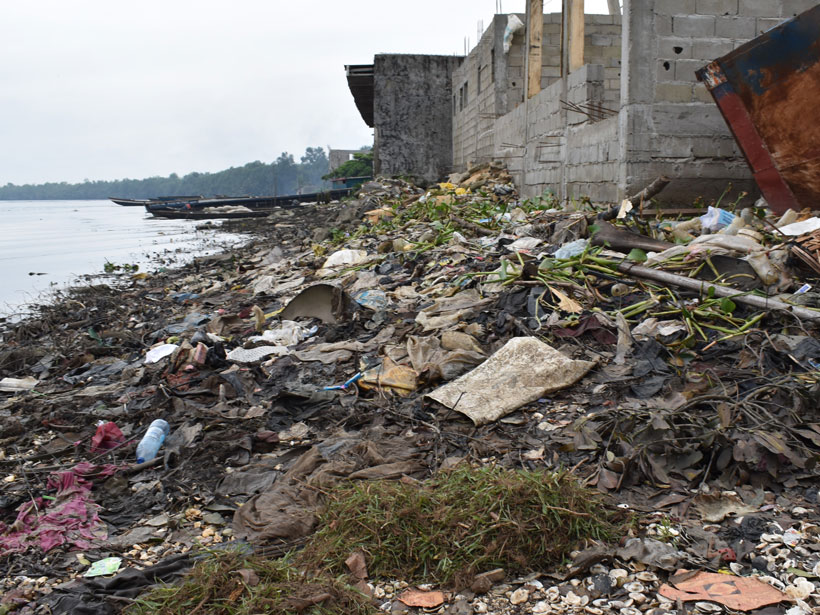
Large amounts of plastic—bottles, cups, bags, plates, and other debris of various shapes and colors—washed up on the nearby boat ramp as we sat down to breakfast at a waterfront restaurant on our first morning in Youpwe, a neighborhood on the Wouri Estuary in Douala, Cameroon. Later that day, we ventured out to explore the nearby shore of the tidal Doctor Creek. We found still more plastic litter—floating on the water, trapped in sediments exposed by the ebbing tide, and caught in the foliage and roots of the otherwise-lush mangrove forest through which the creek flows.
We were in Cameroon on this visit in summer 2019 for a 5-week National Science Foundation–funded International Research Experience for Students to investigate anthropogenic impacts on the estuary. Although the pervasive litter shouldn’t have surprised us, it was shocking nonetheless and offered a stark reminder of the global tragedy of plastic pollution.
Plastic materials are now incorporated into every ecosystem in the world and account for 60%–80% of all marine litter globally.
Plastics are dangerous. Larger pieces break down into smaller and smaller fragments and, eventually, to microplastic particles that never fully decompose. These materials are now incorporated into every ecosystem in the world and account for 60%–80% of all marine litter globally [Bergmann et al., 2015; Carter et al., 2015]. They are even found in rain. Plastics can get into food; strangle, choke, and suffocate marine animals; and entangle vegetation, especially in mangrove forests like those in Douala.
Mangrove forests, the only forests adapted to survive in salt water, are rare despite being found in 123 nations and territories globally. These forests “represent less than 0.4% of the total global forest estate” and are “disappearing three to five times faster than overall global forest losses,” according to the United Nations Educational, Scientific and Cultural Organization (UNESCO). Where mangroves have not yet disappeared, plastic and other pollutants imperil their survival. Solutions to the problems of plastics in mangroves exist, but they require concerted and coordinated efforts to design and implement.
A Vital Ecosystem Locally and Globally
On the Wouri Estuary, the Bantu people, largely represented by the Duala and Bassa tribes, have lived around the mangroves for more than 3,000 years, depending on the ecosystem for their subsistence livelihoods. Mangroves provide plants, game, and fish for food; timber, mud, and sand for building; firewood for fuel; and plants for medicines. The Indigenous Bantu lifestyle is intimately tied to the coastal waters, which are utilized for recreation and ceremonies such as funerals, weddings, coronations, and other celebrations, like the annual 2-week Ngondo festival held at the water’s edge.
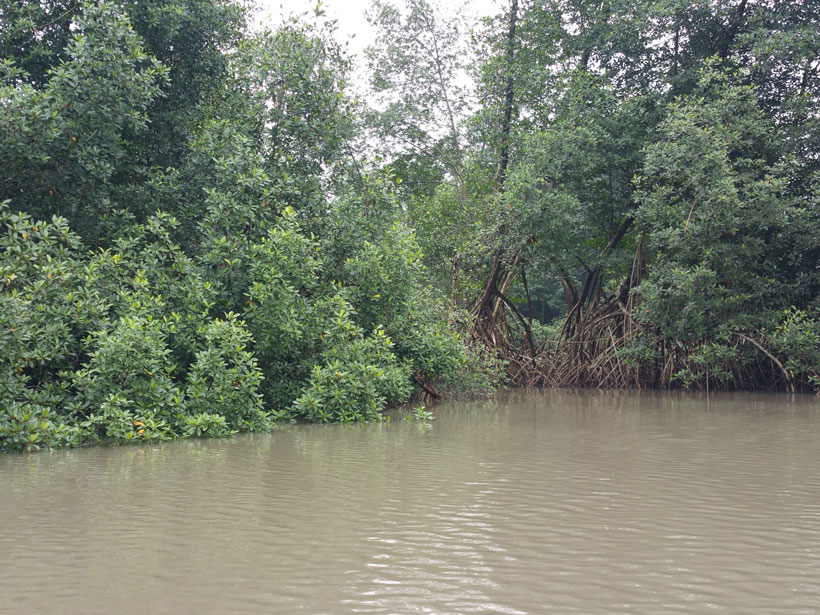
Mangroves provide indirect services too. They protect homes and shelters from torrential rains and floods, slow the rush of strong storm surges and high tides, buffer strong winds, and stabilize shorelines by limiting erosion. Despite their small size relative to the global forest estate, they are some of the most valuable blue carbon sinks in the world [e.g., Alongi, 2014]. Mangrove soils alone, for example, have been estimated to hold more than 6 billion metric tons of carbon, and proportionally, the forests sequester far more carbon than rain forests do.
Because of mangroves’ immense value to both local and the global communities and considering the threats they continue to face, in 2015, UNESCO proclaimed 26 July to be the International Day for the Conservation of the Mangrove Ecosystem, or Mangrove Day.
Human-Induced Stresses on Mangroves
Historically, the Bantu people have been good custodians and environmental stewards of the coastal region of central Africa, including the Wouri mangroves. The mangroves began to deteriorate with the start of European colonialism in the area around 1472, when Portuguese explorers landed and began exploiting natural resources, including the forests and people—activities that eventually were tied into the slave trade.
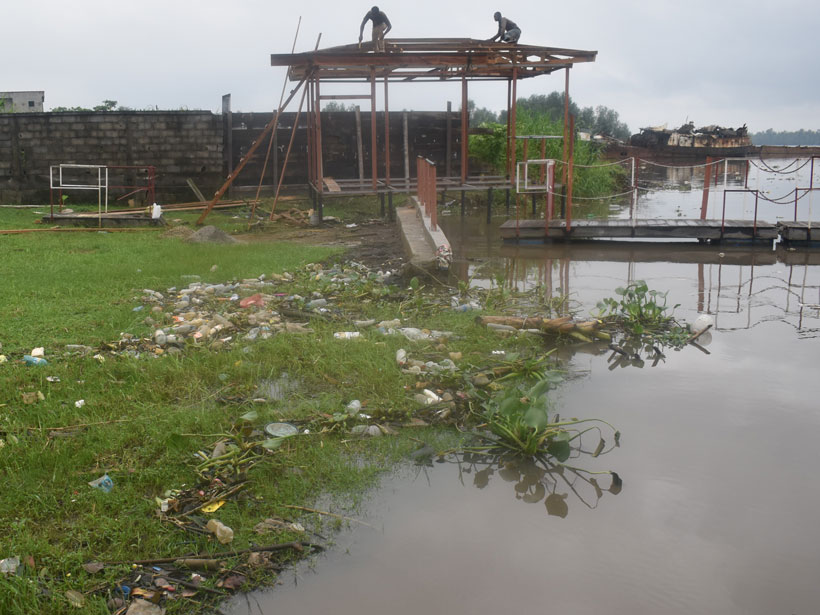
Over the past century, degradation of the Wouri mangrove forests has worsened: Population growth and economic diversification in and around Douala, now a metro area of about 4 million residents, has further stifled Indigenous communities and limited their ability to care for their environment and protect the mangroves. The rising population density in the city increases competition for space, and the mostly subsistence economy of the traditional Duala and Bassa communities has decreased in favor of rapid and unstructured development.
Around the world, mangroves are stressed by environmental perturbations related to climate change, resource exploitation, freshwater diversion from rivers, farming and aquaculture, development of buildings and other infrastructure, overharvesting of timber, hunting, fishing, and pollution [Carter et al., 2015; Osland et al., 2017]. Some, like the Wouri mangroves, also face issues posed by limited or nonexistent resources for solid waste management: In emerging economies like Cameroon’s, litter pollution is ubiquitous in large part because there is inadequate infrastructure to keep up with the waste produced by growing populations.
Plastics in the Wouri
In the Wouri Estuary, the amount and variety of plastic litter are staggering. By their nature, mangroves in estuaries prevent pollutants from getting from the land to the sea, acting as a first barrier that traps litter. However, nature didn’t design the system to handle nonbiodegradable, waterproof, and buoyant plastics, most of which are sequestered indefinitely in the mangroves.
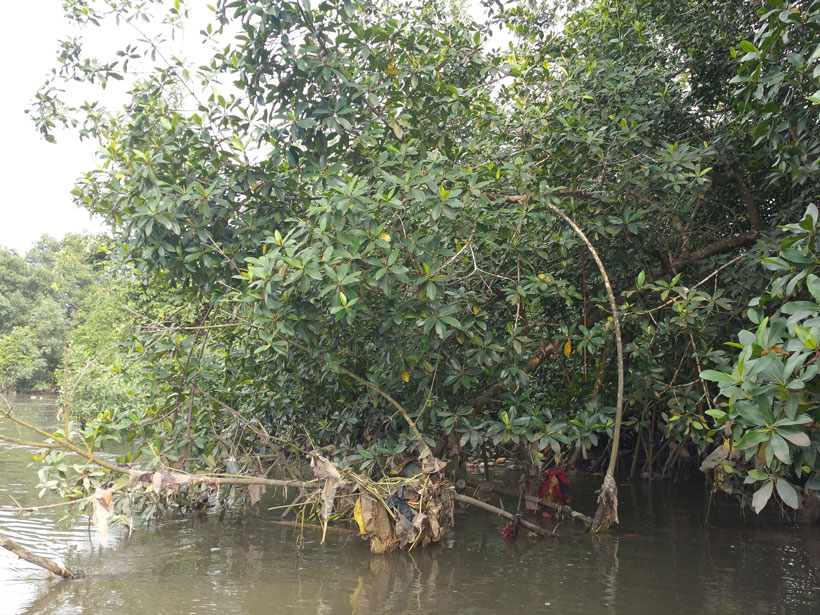
All sizes of plastic get entangled in the foliage and the partially submerged branches and roots of mangrove forests. This pollution is not only aesthetically repulsive, but the plastics are also extremely laborious to access, untangle, and remove. High-density plastics settle to the estuary bed and may be buried in the sediment or get hooked by mangrove shoots, stunting their growth. Plastics can be ingested by and kill marine animals and fish. Abundant litter around the estuary may also hurt the local hospitality and tourism industry [e.g., Bergmann et al., 2015]. Without the litter, the Wouri mangroves are strikingly beautiful, lush, and stratified forests that can attract significant ecotourism.
Plastics are problematic everywhere, but several circumstances make them especially prevalent in the Wouri Estuary. Three major rivers—the Mungo, Wouri, and Dibamba—and several streams converge here, carrying lightweight plastics from dozens of cities and hundreds of villages over hundreds of kilometers. In addition, Douala is Cameroon’s most populous city, and the Port of Douala is the country’s busiest seaport and an important industrial center in central Africa, factors that contribute to growing plastic pollution in the Wouri Estuary. The estuary is also used to move equipment and materials, including plastics, related to hydrocarbon exploration and exploitation both on land and at nearby offshore locations.
A Similar Story in Other Tropical Mangroves
The fate of mangroves in the Wouri Estuary is not unique. Twenty-two of the largest 32 cities in the world are situated on estuaries, according to NOAA, many of which have mangroves thus exposed to pollution from large populations [Spalding et al., 1997]. And similar anthropogenic problems exist in tropical coastal embayments and estuaries in Africa, Asia, and Latin America (from Tanzania to Gabon, Bangladesh to Indonesia, and Brazil to Panama), where more than 80% of mangroves are located. Many of the countries that are home to these mangroves are experiencing rapid population growth and have limited infrastructure for waste management.
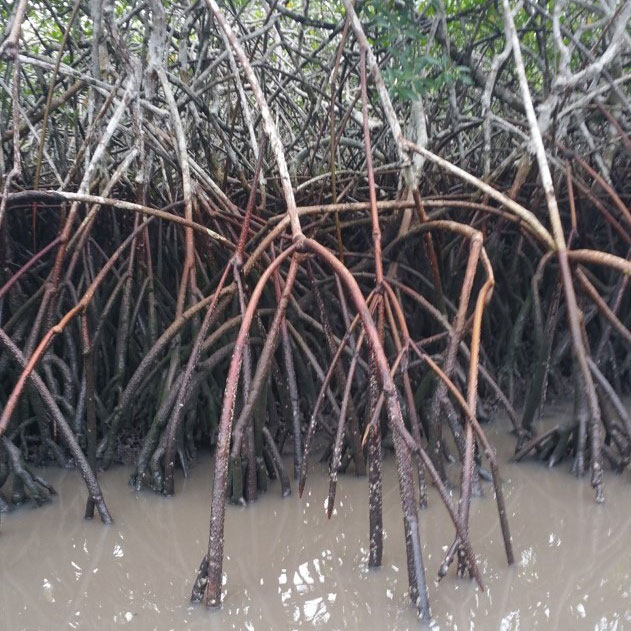
Some studies have suggested that plastics cause more problems in coastal regions of lower-income countries than in those of higher-income countries [e.g., do Sul et al., 2014] because even though lower-income economies may produce less plastic waste, these countries have fewer resources to manage litter disposal. In addition, emerging economies sometimes import plastic waste from elsewhere in a new and flourishing global trade.
In many of these lower-income countries, efforts are being made to manage exploitation of local timber and fisheries as well as coastal degradation like soil loss near mangroves. But plastics are a more recent problem, and despite their overwhelming abundance in many coastal environments, few attempts have been made to manage plastic pollution, and fewer still have succeeded. This lack of successful management is likely due to the varied and diffuse sources of plastic litter in the environment, rapid rates of plastic waste generation and a lack of efforts to curb plastics use, and a lack of clear alternatives for plastic products and incentives to move away from them. In addition, insufficient waste collection and management systems and regulations that are difficult to enforce compound plastic pollution problems.
Combatting Plastic Litter
Resolving problems of plastic pollution and littering requires wide-reaching involvement extending beyond the communities affected.
People in communities around the Wouri Estuary understand the damage that plastics cause to their environment, and they already widely practice reducing, reusing, and recycling of plastics to manage waste. Individuals gather and collect plastics and other litter brought in by tides, salvage and reuse or recycle single-use plastics, and sometimes resort to less sustainable (and toxic) options like burying or burning plastic trash to minimize litter. However, these R’s do not go far enough, as is clear from the plastic pollution and littering that remain and that we ourselves have witnessed. Indeed, resolving these problems requires wide-reaching involvement extending beyond the communities affected.
If cheap plastic goods are available, consumers will default to using them, exacerbating pollution even as it is increasingly acknowledged as a problem. And without appropriate policies, unmitigated use of plastics and unregulated trade in plastic waste will continue. In 2013, for example, the government of Cameroon announced a ban on plastic bags used for packaging. The ban went into effect nationwide on 24 April 2014 but has proven difficult to enforce, perhaps because of the lack of affordable alternative products. A lack of effective collaboration and coordination among stakeholders—including Njangi groups (local groups of people who support each other and sometimes fundraise for a common cause), local city and neighborhood youth cleanup groups, nongovernmental organizations (NGOs), village communities, and schools, among others—and with neighboring countries has also hindered enforcement. Thus, the national government continues to seek effective solutions for the country’s plastic problems.
Sustainable solutions for mitigating plastic pollution on an international scale are possible if countries that mostly supply plastics and export plastic waste and those that mostly consume plastics and receive the plastic waste are empowered and resourced to coordinate their strategies. International organizations like UNESCO and the World Health Organization can help by highlighting the ubiquity and scale of plastic waste globally and leading worldwide cleanup programs (and further amplify existing programs like the National Cleanup Day). Perhaps following the effective model of UNESCO’s Goodwill Ambassadors program, international organizations could also partner with the entertainment industry, sponsoring social influencers as ambassadors to more widely publicize habits that minimize the use of disposable plastics, such as the use of reusable or returnable bottles.
Meanwhile, industries can partner with NGOs to sensitize communities, particularly marginalized groups, to the perils of plastic and to encourage waste recycling at collection points over burning and burial. Large industries can also create partnerships to produce goods locally and minimize packaging used in shipping.
Controlling plastic litter will also require adequate financial and infrastructural resources and significant time and commitment at community and personal levels. For communities in which such resources are limited, we propose the following steps to support efforts to manage litter pollution:
- Promote and incentivize low-plastic living and plastics reuse by highlighting aesthetic and economic benefits to the community (e.g., related to tourism) and providing rewards (e.g., through neighborhood competitions).
- Encourage and fund recycling, physical removal, and proper waste disposal methods. Incentivizing individuals and companies for plastic litter collected for recycling (e.g., per kilogram) is a potential means to promote these practices. Specifically, businesses, suppliers, and stores could be awarded tax credits for plastic litter recycled or collected.
- Identify, train, and support community volunteers and leaders to sustain plastic and other litter cleaning efforts. Word of mouth is a powerful tool in many communities, and community leaders can use their influence to promote waste management and low plastic use.
- Identify initiatives that have proven successful at small scales and incentivize their implementation on larger scales. For example, some groups and communities are revisiting returnable bottle practices that were popular prior to the widespread use of plastics. International organizations partnering with local government and community leadership support (e.g., from NGOs) can incentivize and scale up this practice.
- Engage and collaborate with plastic manufacturers and suppliers to reimagine alternatives to current practices, such as divesting from single-use plastic items and establishing best practices for plastic litter recycling and collection between suppliers and retailers.
- Involve partners beyond the immediate community and borders to, for example, expand efforts to combat plastic smuggling (which proliferated when plastic bags were banned in Cameroon) and reduce upstream disposal of plastic waste into waterways. Plastic is very mobile in the environment, so mitigating its spread and pollution effects requires across-the-board collaboration.
Considered together, coordinated international and national strategies along with steps such as these offer promise for curbing the proliferation of plastics in the Wouri Estuary and in mangrove forests elsewhere around the world.
Acknowledgment
This work is supported by funding from the National Science Foundation, NSF-Collaborative Research: IRES Track I, award 1827072.
References
Alongi, D. M. (2014), Carbon cycling and storage in mangrove forests, Annu. Rev. Mar. Sci., 6(1), 195–219, https://doi.org/10.1146/annurev-marine-010213-135020.
Bergmann, M., L. Gutow, and M. Klages (2015), Marine Anthropogenic Litter, Springer, Cham, Switzerland, https://doi.org/10.1007/978-3-319-16510-3.
Carter, H. N., S. W. Schmidt, and A. C. Hirons (2015), An international assessment of mangrove management: Incorporation in integrated coastal zone management, Diversity, 7(2), 74–104, https://doi.org/10.3390/d7020074.
do Sul, J. A. I., et al. (2014), Plastic debris retention and exportation by a mangrove forest patch, Mar. Pollut. Bull., 78(1–2), 252–257, https://doi.org/10.1016/j.marpolbul.2013.11.011.
Osland, M. J., et al. (2017), Climatic controls on the global distribution, abundance, and species richness of mangrove forests, Ecol. Monogr., 87(2), 341–359, https://doi.org/10.1002/ecm.1248.
Spalding, M., E. Blasco, and C. Field (1997), World Mangrove Atlas, Int. Soc. for Mangrove Ecosyst., Okinawa, Japan.
Author Information
Hendratta Ali ([email protected]), Fort Hays State University, Hays, Kans.; Eliot Atekwana, University of Delaware, Newark; Njilah Isaac Konfor, University of Yaoundé I, Cameroon; Diana Fregoso-Sanchez, California State University, Fullerton; and Germain Corine Ngameni Youaleu, University of Yaoundé I, Cameroon
This story is a part of Covering Climate Now’s week of coverage focused on “Living Through the Climate Emergency.” Covering Climate Now is a global journalism collaboration committed to strengthening coverage of the climate story.
Citation:
Ali, H., E. Atekwana, N. I. Konfor, D. Fregoso-Sanchez, and G. C. N. Youaleu (2021), Cameroon’s mangrove forests are choking on plastics, Eos, 102, https://doi.org/10.1029/2021EO157358. Published on 21 April 2021.
Text © 2021. The authors. CC BY-NC-ND 3.0
Except where otherwise noted, images are subject to copyright. Any reuse without express permission from the copyright owner is prohibited.

